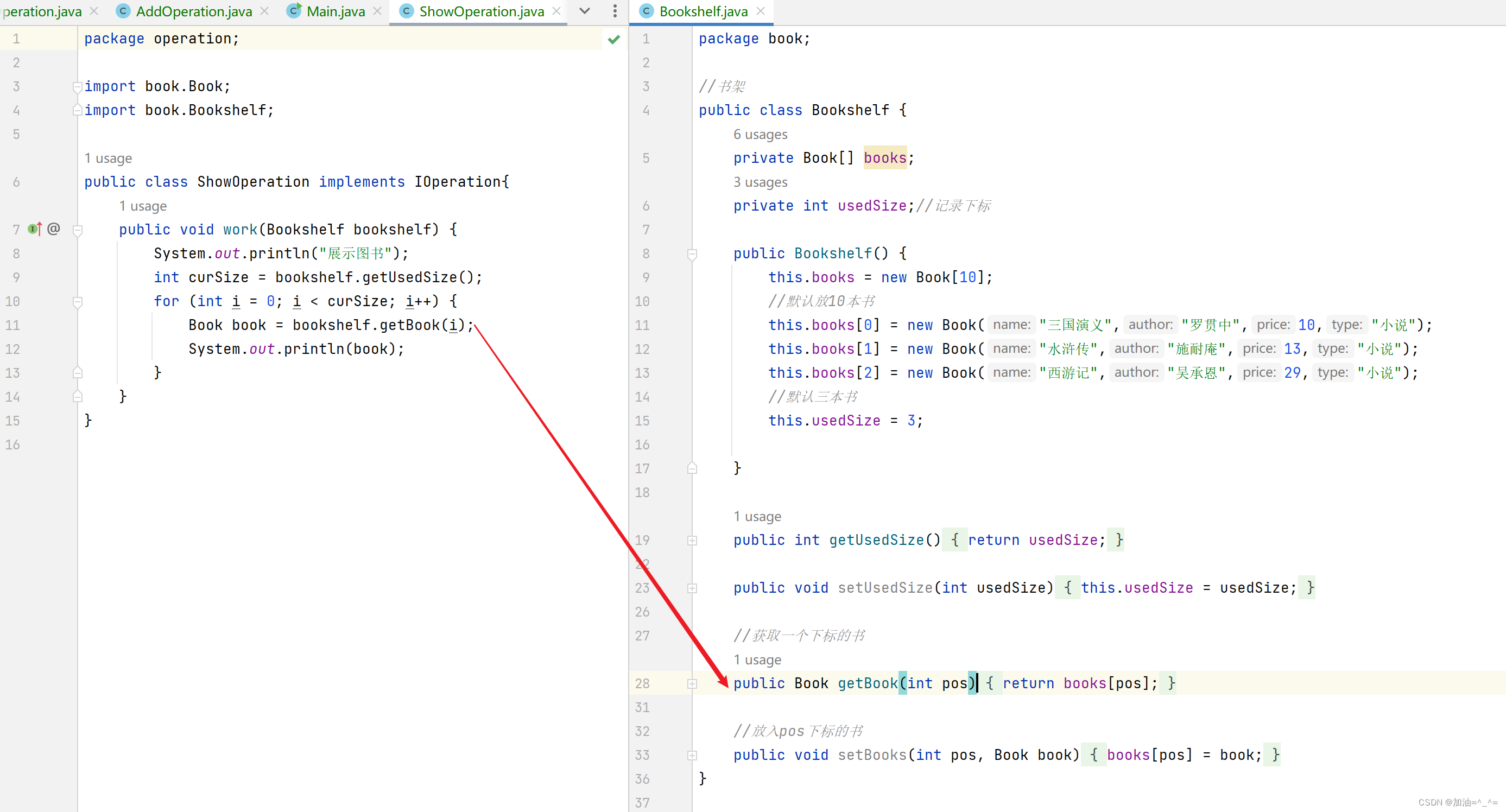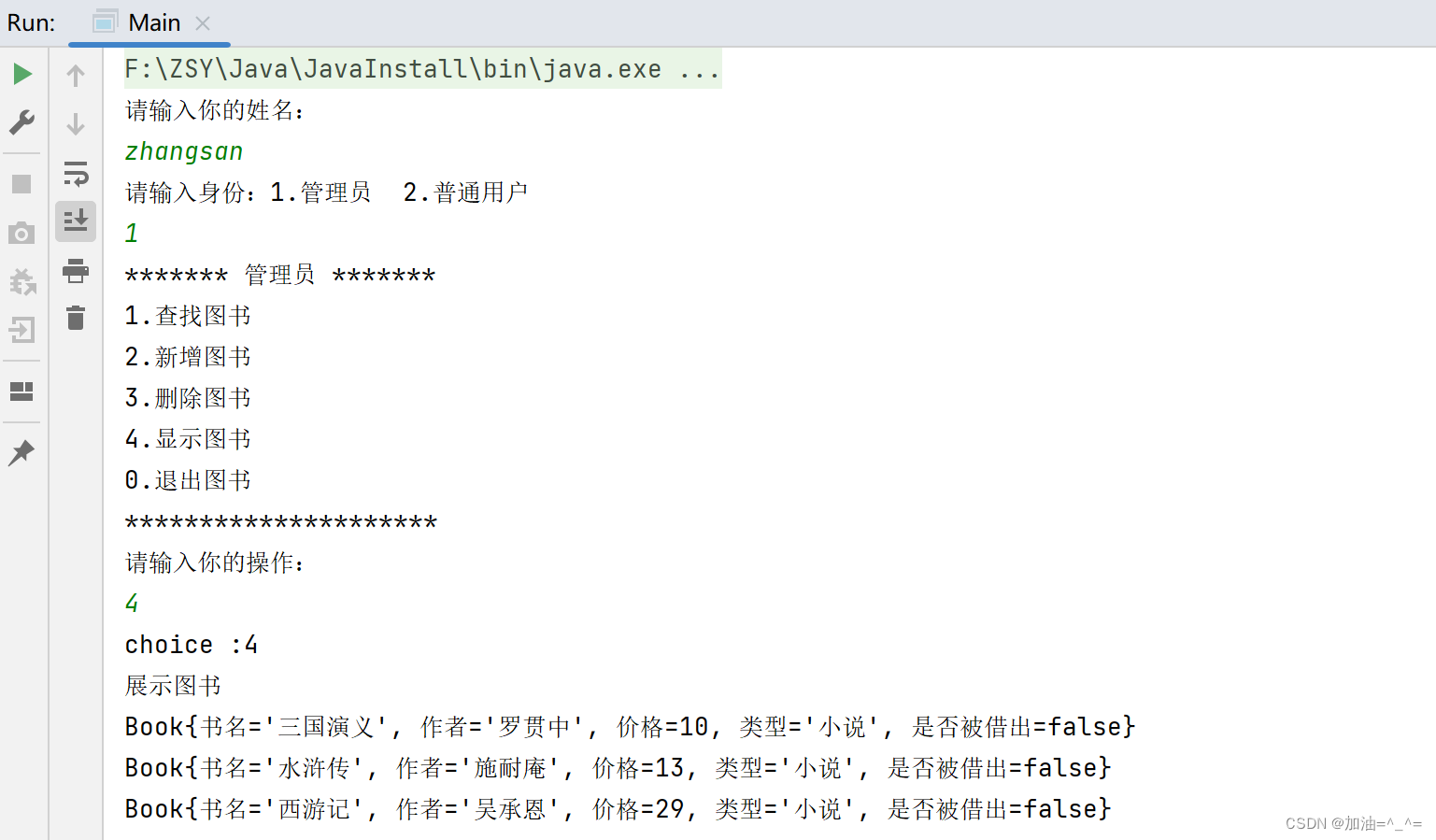目录
前言:
因为Java是面向对象的语言,所以相对C语言,实现一个图书管理系统是相对容易的,这一篇我们来讲解图书管理系统(当然是简易版的)。
先介绍一下这个图书管理系统,它有两个身份,一个图书管理员,一个普通用户。每一个对应的操作权限不一样。并且这个系统有借阅和归还功能。
框架:
书:
我们先去创建一个包,这样分工并高效完成这个项目。
面向对象,第一个想到的肯定是书,所以我们要创建一个Book类,书就有书名,作者,价格,类型。因为我们这个会有借阅和归还,所以我们再加一个是否借阅的属性。
在正式使用时,我们一般会考虑其安全性,所以我们令每一个成员变量为私有属性,通过get和set方法设置和获取(不要手敲,如果你用的是IDEA,可以右键点击Generate,点击Getter and Setter把属性全部选中一键生成)。
//书
public class Book {
private String name;
private String author;
private int price;
private String type;
private boolean isBorrowed;
public Book(String name, String author, int price, String type) {
this.name = name;
this.author = author;
this.price = price;
this.type = type;
}//这里构造方法没有isBorrow参数,是因为我们不能由输入而定
public String getName() {
return name;
}
public void setName(String name) {
this.name = name;
}
public String getAuthor() {
return author;
}
public void setAuthor(String author) {
this.author = author;
}
public int getPrice() {
return price;
}
public void setPrice(int price) {
this.price = price;
}
public String getType() {
return type;
}
public void setType(String type) {
this.type = type;
}
public boolean isBorrowed() {
return isBorrowed;
}
public void setBorrowed(boolean borrowed) {
isBorrowed = borrowed;
}
}这里我们使用了有参构造器,但是并没有传入isBorrow参数, 是因为我们初始化本身是未借出,不能根据用户输入而定(这些细节都不可忽略)。
我为了方便打印,重写toString方法,但是要可能要稍作修改。
public String toString() {
return "Book{" +
"书名='" + name + '\'' +
", 作者='" + author + '\'' +
", 价格=" + price +
", 类型='" + type + '\'' +
", 是否被借出=" + isBorrowed +
'}';
}此时就完成了书这个类。
书架:
书应该放在书架上,所以在定义一个Bookshelf类,这里面会存放多本书。但是我们知道,这就相当于定义了一个Book的数组了,所以我们要记录容量和当前有多少本书,构造方法作为将书架生成10本书的空间。接下来给出代码:
//书架
public class Bookshelf {
private Book[] books;
private int usedSize;//记录下标
public Bookshelf() {
this.books = new Book[10];
//默认放10本书
}
public int getUsedSize() {
return usedSize;
}
public void setUsedSize(int usedSize) {
this.usedSize = usedSize;
}
//获取一个下标的书
public Book getBook(int pos) {
return books[pos];
}
//放入pos下标的书
public void setBooks(int pos, Book book) {
books[pos] = book;
}
} 我们目前只是框架有很多细节先不要针对。
这个类其实已经可以完成了所有操作了,但是这样可读性会很低。
操作相关:
所以我们再创建一个和操作有关的包,这里面的类来完成有关书的各类操作。

这些所有的类,都相当于操作书架,所以我们在每一个类中都写入操作书架的方法。
public void work(Bookshelf bookshelf) {
}因为所有操作都是要操作书架的,所以我们定义一个接口,接口中写一个抽象方法,这个方法就是操作书架。之后所有操作有关的类使用这个接口并重写方法。
public interface IOperation {
void work(Bookshelf bookshelf);
}
用户相关:
我们因为每个使用的用户不用,操作权限也不同,所以我们再定义一个user包。 因为操作的都是人,所以我们先写一个大类User。这个里面的name我并不想让其他包非子类使用,所以我们使用protected修饰,其他包使用必须继承这个类并使用super关键字调用。
public class User {
protected String name;
//除非其他包继承该类并使用super调用,否则无法调用
public User(String name) {
this.name = name;
//构造方法
}
}之后创建AdminUser类和NormalUser类,都继承于User类。
public class AdminUser extends User{
public AdminUser(String name) {
super(name);
}
}public class NormalUser extends User{
public NormalUser(String name) {
super(name);
}
}当我们确定身份完以后,就会直接打印出菜单,所以我们在里面写入menu方法,注意两个身份不同,对应菜单不同。

因为不同身份对应操作权限不同,所以我们可以通过方法重写来是菜单展现不同。所以大家是否想到了多态?我们直接在User里面定义一个抽象menu方法,之后使继承User的类直接重写并通过向上转型就可以打印出不同菜单了。所以我们将User定义为抽象类,并往里面写入抽象menu方法。
public abstract class User {
protected String name;
public User(String name) {
this.name = name;
//构造方法
}
public abstract int menu();
}AdminUser中的菜单:
public void menu() {
System.out.println("*******************");
System.out.println("1.查找图书");
System.out.println("2.新增图书");
System.out.println("3.删除图书");
System.out.println("4.显示图书");
System.out.println("0.退出图书");
System.out.println("*******************");
}NormalUser中的菜单:
public void menu() {
System.out.println("*******************");
System.out.println("1.查找图书");
System.out.println("2.借阅图书");
System.out.println("3.归还图书");
System.out.println("0.退出图书");
System.out.println("*******************");
}主类:
之后为了完成所有操作,我们写一个主方法。我们先调用登录方法(login):
public class Main {
public static User login() {
//先登录
System.out.println("请输入你的姓名:");
Scanner scanner = new Scanner(System.in);
String name = scanner.nextLine();
System.out.println("请输入身份:1.管理员 2.普通用户");
int choice = scanner.nextInt();
if (choice == 1) {
//管理员
return new AdminUser(name);
} else {
//普通用户
return new NormalUser(name);
}
}
public static void main(String[] args) {
User user = login();
}
}此时就确定了用户类型(以上代码有Bug,但是可以跑,各位可以参考以后完善,但是不影响阅读),之后去调用menu方法。
public static void main(String[] args) {
User user = login();
user.menu();
}我们要一边运行一边写代码,这样可以及时发现错误。所以建议大家先运行一下。
此时大框架就已经完成了,恭喜你已经完成了二分之一。那么接下来我们就进行其他具体细节的完善。
细节完善:
Main、User和Bookshelf完善:
确定身份之后就需要进行操作了,我们在menu方法中写入。
public class NormalUser extends User{
public NormalUser(String name) {
super(name);
}
public int menu() {
System.out.println("******** 普通用户 ******");
System.out.println("1.查找图书");
System.out.println("2.借阅图书");
System.out.println("3.归还图书");
System.out.println("0.退出图书");
System.out.println("***********************");
Scanner scanner = new Scanner(System.in);
System.out.println("请输入你的操作:");
int choice = scanner.nextInt();
return choice;
}
}注意我们改写了menu方法,进行了返回,所以此时就需要改写抽象User类中的方法。
//在抽象类User中,此时将void改为int
//public abstract void menu();
public abstract int menu();因为不同用户对应的操作不同,所以此时我们在User中再定义一个IOperation接口数组,确定都会使用哪些方法。
public abstract class User {
protected String name;
//除非其他包继承该类并使用super调用,否则无法调用
protected IOperation[] iOperations;
public User(String name) {
this.name = name;
//构造方法
}
public abstract int menu();
} 之后在管理员和普通成员类中,我们确定完身份以后就执行了构造方法,所以我们在其构造方法中确定会有哪些操作即可(既定义IOperation数组又哪些操作)。
此时已经确定了哪些用户会有哪些操作,但是如何调用呢?
所以我们在User类中定义一个执行操作的方法,参数为choice和Bookshelf,这样就确定执行什么操作了。
//User类中
public void doOperation(int choice, Bookshelf bookshelf) {
iOperations[choice].work(bookshelf);
} 用户不止会操作一次,所以我们循环调用。而且因为书架只能有一个,所以我们在使用主方法时,就新创建一个书架。 此时放10本书,但是每一个引用都指向的是null。但是此时默认书架上有3本书。所以在Bookshelf中的构造方法里面写入:
此时放10本书,但是每一个引用都指向的是null。但是此时默认书架上有3本书。所以在Bookshelf中的构造方法里面写入:
public Bookshelf() {
this.books = new Book[10];
//默认放10本书
this.books[0] = new Book("三国演义","罗贯中",10,"小说");
this.books[1] = new Book("水浒传","施耐庵",13,"小说");
this.books[2] = new Book("西游记","吴承恩",29,"小说");
//默认三本书
this.usedSize = 3;
}此时就差完善operation包中的类了。
ShowOperation完善:
public class ShowOperation implements IOperation{
public void work(Bookshelf bookshelf) {
System.out.println("展示图书");
int curSize = bookshelf.getUsedSize();
for (int i = 0; i < curSize; i++) {
Book book = bookshelf.getBook(i);
System.out.println(book);
}
}
}
我们默认三本书,所以我们打印一下。 
但是此时我们发现借出打印的并不符合预期,所以我们进行改写。
//在Book类中的toString方法。
@Override
public String toString() {
return "Book{" +
"书名='" + name + '\'' +
", 作者='" + author + '\'' +
", 价格=" + price +
", 类型='" + type + '\'' +
((isBorrowed == true) ? ", 已被借出" : ", 未被借出") +
/*", 是否被借出=" + isBorrowed +*/
'}';
}FindOperation完善:
public class FindOperation implements IOperation{
public void work(Bookshelf bookshelf) {
System.out.println("查找图书");
Scanner scanner = new Scanner(System.in);
String name = scanner.nextLine();
int cur = bookshelf.getUsedSize();
for (int i = 0; i < cur; i++) {
Book book = bookshelf.getBook(i);
if (name.equals(book.getName())) {
System.out.println("找到了,信息如下:");
System.out.println(book);
return;
}
}
System.out.println("没有找到这本书");
}
}AddOperation完善:
我们添加图书,一般是先看书架满了没有,之后判断是否重复添加(不考虑有重复的书名),所以此时在书架中添加无参构造器,并添加一个返回最大容量的方法。
public class AddOperation implements IOperation{
public void work(Bookshelf bookshelf) {
System.out.println("增加图书");
int cur = bookshelf.getUsedSize();
//看看书架是否已经满了
if (cur == bookshelf.getBooks().length) {
System.out.println("书架已满");
} else {
Book book = new Book();
Scanner scanner = new Scanner(System.in);
System.out.println("请输入书的名称:");
book.setName(scanner.nextLine());;
System.out.println("请输入书的作者:");
book.setAuthor(scanner.nextLine());;
System.out.println("请输入书的价格:");
book.setPrice(scanner.nextInt());
//注意这里面有一个 回车 我们要将其消化掉
scanner.nextLine();
System.out.println("请输入书的类型");
book.setType(scanner.nextLine());
//检查数组中有没有这本书
for (int i = 0; i < cur; i++) {
Book book1 = bookshelf.getBook(i);
if (book.getName().equals(book1)) {
System.out.println("这本书已经有了");
return;
}
}
bookshelf.setBooks(cur,book);
bookshelf.setUsedSize(cur++);
System.out.println("添加成功!");
}
}
}注意此时在Book中添加无参构造器(大家真的完善时不要学我,否则private修饰则失去了意义):
//在Book中添加无参构造器
public Book() {
}DelOperation完善:
删除操作,我们进行对比,之后找到把后面内容先前覆盖,把最后一个置null。
public class DelOperation implements IOperation{
public void work(Bookshelf bookshelf) {
System.out.println("删除图书");
Scanner scanner = new Scanner(System.in);
System.out.println("请输入要删除的书名:");
String name = scanner.nextLine();
int cur = bookshelf.getUsedSize();
for (int i = 0; i < cur; i++) {
Book book = bookshelf.getBook(i);
if (book.getName().equals(name)) {
//删除
//后面的向前覆盖
int j = i;
for ( ; j < bookshelf.getUsedSize() - 1; j++) {
bookshelf.setBooks(j,bookshelf.getBook(j + 1));
}
System.out.println("删除成功");
//最后把 j 位置置空
bookshelf.setBooks(j,null);
bookshelf.setUsedSize(cur - 1);
return;
}
}
System.out.println("没有这本书");
}
}ExitOperation完善:
退出操作,直接进行强制退出。
public class ExitOperation implements IOperation{
public void work(Bookshelf bookshelf) {
System.out.println("退出系统");
System.exit(0);
//直接强制退出
}
}之后我们来看看普通用户的操作。
BorrowOperation完善:
借阅操作和查询操作很像。
public class BorrowOperation implements IOperation{
public void work(Bookshelf bookshelf) {
System.out.println("借阅图书");
Scanner scanner = new Scanner(System.in);
System.out.println("请输入要借阅的书名");
String name = scanner.nextLine();
int cur = bookshelf.getUsedSize();
for (int i = 0; i < cur; i++) {
Book book = bookshelf.getBook(i);
if (name.equals(book.getName())) {
//查看借阅状态
if (book.isBorrowed()) {
System.out.println("已被借阅,无法借阅");
} else {
book.setBorrowed(true);
System.out.println("借阅成功");
}
return;
}
}
//没有找到
System.out.println("没有此书");
}
}ReturnOperation完善:
归还图书和借阅图书逻辑一样。
public class ReturnOperation implements IOperation{
public void work(Bookshelf bookshelf) {
System.out.println("归还图书");
Scanner scanner = new Scanner(System.in);
System.out.println("请输入要归还的书名");
String name = scanner.nextLine();
int cur = bookshelf.getUsedSize();
for (int i = 0; i < cur; i++) {
Book book = bookshelf.getBook(i);
if (name.equals(book.getName())) {
//查看归还状态
if (book.isBorrowed()) {
book.setBorrowed(false);
System.out.println("归还成功");
} else {
System.out.println("已被归还,无法归还");
}
return;
}
}
//没有找到
System.out.println("没有此书");
}
} 注意它和BorrowOperation一样,就是看归还状态那里反了过来。
全部代码:
那么接下来相信你也看完了全部过程,附上全部代码:
Main:
public class Main {
public static User login() {
//先登录
System.out.println("请输入你的姓名:");
Scanner scanner = new Scanner(System.in);
String name = scanner.nextLine();
System.out.println("请输入身份:1.管理员 2.普通用户");
int choice = scanner.nextInt();
if (choice == 1) {
//管理员
return new AdminUser(name);
} else {
//普通用户
return new NormalUser(name);
}
}
public static void main(String[] args) {
Bookshelf bookshelf = new Bookshelf();
User user = login();
while(true) {
int choice = user.menu();
//根据 choice 的选择 来决定调用的是哪个方法
/*user.doOperation(choice,new Bookshelf());*/
//这里不能每次都new
user.doOperation(choice,bookshelf);
}
}
}Book:
//书
public class Book {
private String name;
private String author;
private int price;
private String type;
private boolean isBorrowed;
public Book(String name, String author, int price, String type) {
this.name = name;
this.author = author;
this.price = price;
this.type = type;
}//这里构造方法没有isBorrow参数,是因为我们不能由输入而定
public Book() {
}
public String getName() {
return name;
}
public void setName(String name) {
this.name = name;
}
public String getAuthor() {
return author;
}
public void setAuthor(String author) {
this.author = author;
}
public int getPrice() {
return price;
}
public void setPrice(int price) {
this.price = price;
}
public String getType() {
return type;
}
public void setType(String type) {
this.type = type;
}
public boolean isBorrowed() {
return isBorrowed;
}
public void setBorrowed(boolean borrowed) {
isBorrowed = borrowed;
}
@Override
public String toString() {
return "Book{" +
"书名='" + name + '\'' +
", 作者='" + author + '\'' +
", 价格=" + price +
", 类型='" + type + '\'' +
((isBorrowed == true) ? ", 已被借出" : ", 未被借出") +
/*", 是否被借出=" + isBorrowed +*/
'}';
}
}Bookshelf:
//书架
public class Bookshelf {
private Book[] books;
private int usedSize;//记录下标
public Bookshelf() {
this.books = new Book[10];
//默认放10本书
this.books[0] = new Book("三国演义","罗贯中",10,"小说");
this.books[1] = new Book("水浒传","施耐庵",13,"小说");
this.books[2] = new Book("西游记","吴承恩",29,"小说");
//默认三本书
this.usedSize = 3;
}
public int getUsedSize() {
return usedSize;
}
public void setUsedSize(int usedSize) {
this.usedSize = usedSize;
}
//获取一个下标的书
public Book getBook(int pos) {
return books[pos];
}
//放入pos下标的书
public void setBooks(int pos, Book book) {
books[pos] = book;
}
//为了获取最大容量
public Book[] getBooks() {
return books;
}
}
IOperation接口:
public interface IOperation {
void work(Bookshelf bookshelf);
}AddOperation:
public class AddOperation implements IOperation{
public void work(Bookshelf bookshelf) {
System.out.println("增加图书");
int cur = bookshelf.getUsedSize();
//看看书架是否已经满了
if (cur == bookshelf.getBooks().length) {
System.out.println("书架已满");
} else {
Book book = new Book();
Scanner scanner = new Scanner(System.in);
System.out.println("请输入书的名称:");
book.setName(scanner.nextLine());;
System.out.println("请输入书的作者:");
book.setAuthor(scanner.nextLine());;
System.out.println("请输入书的价格:");
book.setPrice(scanner.nextInt());
//注意这里面有一个 回车 我们要将其消化掉
scanner.nextLine();
System.out.println("请输入书的类型");
book.setType(scanner.nextLine());
//检查数组中有没有这本书
for (int i = 0; i < cur; i++) {
Book book1 = bookshelf.getBook(i);
if (book.getName().equals(book1)) {
System.out.println("这本书已经有了");
return;
}
}
bookshelf.setBooks(cur,book);
bookshelf.setUsedSize(cur + 1);
System.out.println("添加成功!");
}
}
}BorrowOperation:
public class BorrowOperation implements IOperation{
public void work(Bookshelf bookshelf) {
System.out.println("借阅图书");
Scanner scanner = new Scanner(System.in);
System.out.println("请输入要借阅的书名");
String name = scanner.nextLine();
int cur = bookshelf.getUsedSize();
for (int i = 0; i < cur; i++) {
Book book = bookshelf.getBook(i);
if (name.equals(book.getName())) {
//查看借阅状态
if (book.isBorrowed()) {
System.out.println("已被借阅,无法借阅");
} else {
book.setBorrowed(true);
System.out.println("借阅成功");
}
return;
}
}
//没有找到
System.out.println("没有此书");
}
}DelOperation:
public class DelOperation implements IOperation{
public void work(Bookshelf bookshelf) {
System.out.println("删除图书");
Scanner scanner = new Scanner(System.in);
System.out.println("请输入要删除的书名:");
String name = scanner.nextLine();
int cur = bookshelf.getUsedSize();
for (int i = 0; i < cur; i++) {
Book book = bookshelf.getBook(i);
if (book.getName().equals(name)) {
//删除
//后面的向前覆盖
int j = i;
for ( ; j < bookshelf.getUsedSize() - 1; j++) {
bookshelf.setBooks(j,bookshelf.getBook(j + 1));
}
System.out.println("删除成功");
//最后把 j 位置置空
bookshelf.setBooks(j,null);
bookshelf.setUsedSize(cur - 1);
return;
}
}
System.out.println("没有这本书");
}
}ExitOperation:
public class ExitOperation implements IOperation{
public void work(Bookshelf bookshelf) {
System.out.println("退出系统");
System.exit(0);
//直接强制退出
}
}FindOperation:
public class FindOperation implements IOperation{
public void work(Bookshelf bookshelf) {
System.out.println("查找图书");
Scanner scanner = new Scanner(System.in);
String name = scanner.nextLine();
int cur = bookshelf.getUsedSize();
for (int i = 0; i < cur; i++) {
Book book = bookshelf.getBook(i);
if (name.equals(book.getName())) {
System.out.println("找到了,信息如下:");
System.out.println(book);
return;
}
}
System.out.println("没有找到这本书");
}
}ReturnOperation:
public class ReturnOperation implements IOperation{
public void work(Bookshelf bookshelf) {
System.out.println("归还图书");
Scanner scanner = new Scanner(System.in);
System.out.println("请输入要归还的书名");
String name = scanner.nextLine();
int cur = bookshelf.getUsedSize();
for (int i = 0; i < cur; i++) {
Book book = bookshelf.getBook(i);
if (name.equals(book.getName())) {
//查看归还状态
if (book.isBorrowed()) {
book.setBorrowed(false);
System.out.println("归还成功");
} else {
System.out.println("已被归还,无法归还");
}
return;
}
}
//没有找到
System.out.println("没有此书");
}
}ShowOperation:
public class ShowOperation implements IOperation{
public void work(Bookshelf bookshelf) {
System.out.println("展示图书");
int curSize = bookshelf.getUsedSize();
for (int i = 0; i < curSize; i++) {
Book book = bookshelf.getBook(i);
System.out.println(book);
}
}
}User:
public abstract class User {
protected String name;
//除非其他包继承该类并使用super调用,否则无法调用
protected IOperation[] iOperations;
public User(String name) {
this.name = name;
//构造方法
}
public abstract int menu();
public void doOperation(int choice, Bookshelf bookshelf) {
iOperations[choice].work(bookshelf);
}
}AdminUser:
public class AdminUser extends User{
public AdminUser(String name) {
super(name);
//在调用构造方法之后就确定会有哪些方法
this.iOperations = new IOperation[] {new ExitOperation(),
new FindOperation(),new AddOperation(),
new DelOperation(),new ShowOperation()};
}
public int menu() {
System.out.println("******* 管理员 *******");
System.out.println("1.查找图书");
System.out.println("2.新增图书");
System.out.println("3.删除图书");
System.out.println("4.显示图书");
System.out.println("0.退出图书");
System.out.println("*********************");
Scanner scanner = new Scanner(System.in);
System.out.println("请输入你的操作:");
int choice = scanner.nextInt();
return choice;
}
}NormalUser:
public class NormalUser extends User{
public NormalUser(String name) {
super(name);
this.iOperations = new IOperation[] {new ExitOperation(),
new FindOperation(),new BorrowOperation(),
new ReturnOperation()};
}
public int menu() {
System.out.println("******** 普通用户 ******");
System.out.println("1.查找图书");
System.out.println("2.借阅图书");
System.out.println("3.归还图书");
System.out.println("0.退出图书");
System.out.println("***********************");
Scanner scanner = new Scanner(System.in);
System.out.println("请输入你的操作:");
int choice = scanner.nextInt();
return choice;
}
}总结:
我们想好整体框架以后,再去完善细节就会比较轻松。以上项目还有很多问题,比如我们输入身份时输入错误也会继续运行,而且每次都没有把改变的书记录下来,所以大家下来可以再完善一下,博主以后也会根据所学知识来改善,希望大家点点赞。





















 3万+
3万+











 被折叠的 条评论
为什么被折叠?
被折叠的 条评论
为什么被折叠?








